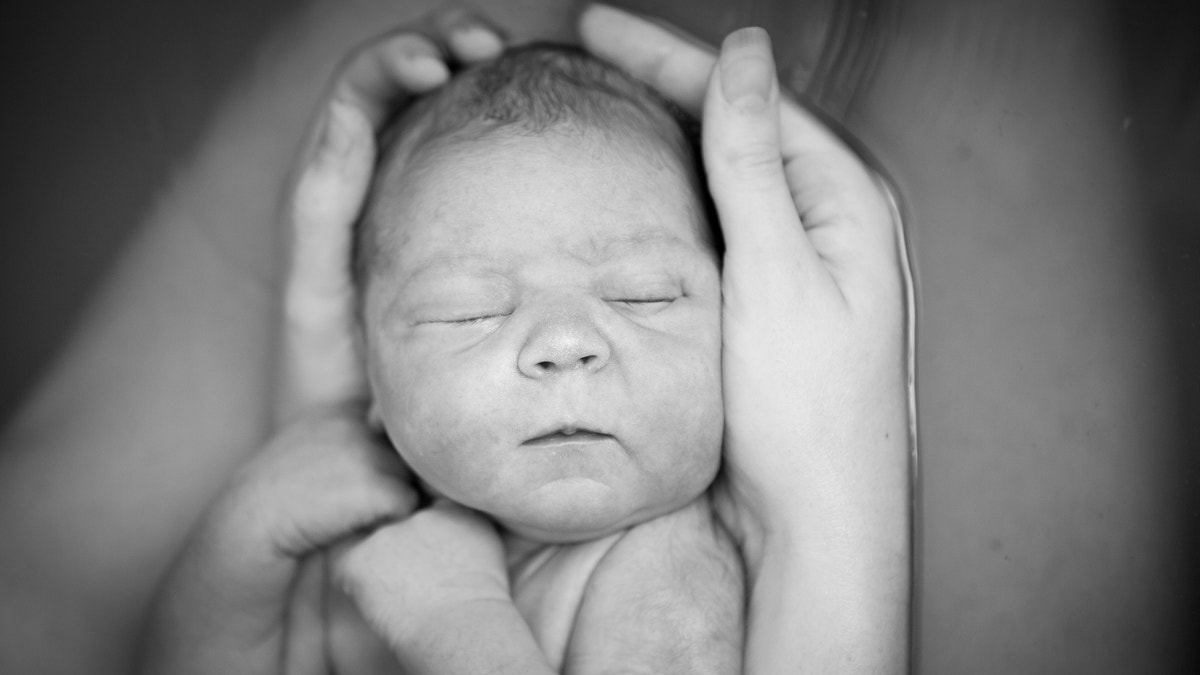
Black and white image of a young mother holding her newborn son after giving birth at home. (ArtisticCaptures)
It’s soothing! It’s natural! It’s…just like giving birth in your childhood kiddie pool? Fans say that water birthing offers a relaxing environment and natural pain relief without anesthesia.
The practice is controversial, though: In 2014, the American College of Obstetricians and Gynecologists and the American Academy of Pediatrics issued a joint statement urging caution during the second stage of labor in particular, due to potential issues, such as umbilical cord rupture as the newborn is being lifted out of the water or infections caused by using water from a contaminated source (you should use a drinking water hose and connect it to your sink to fill up the tub). Many of these births take place at home, as not all hospitals permit water births. (Heal your whole body with Rodale's 12-day power plan for better health.)
Clearly, aquatic birthing isn’t for every pregnant mom. But these two women wouldn’t have done it any other way.
For Boston’s Kara Rea, 28, the decision seemed logical. Her mother-in-law had her children at home, and her husband had witnessed three of his siblings being born. ("Our daughter was his fourth home birth," she laughs.)
Though Kara considered going to a nearby hospital for delivery, she was dismayed at the drugs they recommended to induce labor after her water broke, saying she had just 48 hours to decide. Alarmed, she quickly called a midwife recommended by a leader in her Bradley Method class, which teaches natural childbirth.
RELATED: 10 SUPER ANNOYING THINGS DUDES HAVE DONE WHILE THEIR PARTNERS WERE IN LABOR
The family met their midwife on a Saturday morning—and promptly bought a blow-up tub from her. They filled the tub with warm water attached from their washing machine hookup to a hose, and soon enough, it was go time. By Saturday night, Kara was in labor with her husband by her side. Her mom and dog were on the scene, too.
Her midwife advised her to get out of the tub from time to time, because "sometimes if you’re in the water too long, your labor can stall," says Kara. "The midwife told me, 'Even stepping in and out of the tub is helping to bring the baby out.'"
After about 12 hours, her daughter was born in the water in the middle of their living room.
"One push and the head was out, her shoulders flew out, and the midwife quickly turned her and put her on my chest," says Kara. "She was so happy—her eyes were wide open, she had pink rosy cheeks, and she was so strong." Kara didn’t even suffer much vaginal tearing, which she attributes to the water. (According to a study published in the European Journal of Obstetrics and Gynecology and Reproductive Biology, pushing out a baby in the water is associated with a reduction of perineal trauma for first-time moms.)
Of course, she wondered what could have gone wrong.
"At first I couldn’t wrap my head around doing it—what if something happened?" she says. "My midwife told me, 'There are situations, and there are emergencies. If something goes wrong, we’d get you to the hospital." Since she was young and healthy, she felt confident, and she hopes to do it again with future kids. All told, the procedure cost $4,000 (the midwife wasn’t covered by insurance), plus $70 for the tub.
It was money well spent, she says. But next time, she’ll buy a tub liner.
RELATED: WHY YOU SHOULDN'T FREAK OUT ABOUT CHILDBIRTH
"A major con was my husband having to clean everything up," she says. "We had to hose everything down outside, which was pretty gross."
San Diego’s Stephanie Greunke, 30, also had a water birth with her first child. And it went swimmingly.
"I was having a home birth and wanted as many pain-relieving strategies as possible," she says. "I wanted to reduce pain with the least amount of intervention. Plus, it’s been shown to reduce tearing because your body is so relaxed."
So relaxed that labor can regress. Stephanie says that many midwives don’t want patients to hit the water until they’re very dilated.
"With my first, I handled labor well, and when my midwife came, she couldn't believe how far along I was," she says. "I asked her if I could get into the water. She said, 'Let’s wait. Let’s see some more contractions.'"
Too late: Stephanie insisted she was ready to push. At that point, her midwife checked for dilation (they normally don’t check unless asked, says Stephanie); she was totally dilated, so she eased on in.
Here’s where advance planning could have helped: Her husband had filled the tub with very hot water connected from their shower to a hose, thinking it’d be awhile. Ideally, the temperature should be about 97 degrees. After cooling things down, she was able to labor in earnest.
"From the moment I stepped in the pool, I felt a 180 on my pain," says Stephanie. "I was in for about three hours, hunched over and leaning out when I had my son. My husband was holding my hand. My midwives were on the other side of me—mine didn’t get in, but some do—helping me with pushing."
RELATED: 3 LABOR-INDUCING TRICKS THAT ACTUALLY WORK (AND ONE THAT’LL JUST GIVE YOU THE RUNS)
Her pool cost $300 (she bought it from birthpoolinabox.com), and she plans to repeat the home water birth with her next child, due soon. Right now, the pool sits ready and waiting in her bedroom.
Overall, she says the experience was incredibly mellow.
"The lights were turned off, and it was really comfortable," she says. "The same conditions that get a baby in get a baby out."
Curious? Both women suggest checking out Evidence Based Birth for more information.
This article first appeared on Women's Health.
